Avulsion Fracture Of The Anterior Superior Iliac Spine
What is an Avulsion Fracture Of The Anterior Superior Iliac Spine?
An avulsion fracture of the anterior superior iliac spine is a type of injury that commonly occurs in adolescents involved in sports activities, particularly those that involve sudden, forceful muscle contractions.
The anterior superior iliac spine is a bony projection located at the front of the iliac crest, and it serves as an attachment site for the inguinal ligament and the sartorius muscle.
During explosive movements, such as sprinting or kicking, the powerful contraction of the attached muscles can exert excessive force on the anterior superior iliac spine, leading to a fracture or avulsion.
This type of injury is often characterized by a sudden, sharp pain at the front of the hip, accompanied by swelling and tenderness. Diagnosis is typically confirmed through physical examination and imaging studies such as X-rays or MRI scans, which can reveal the extent of the fracture and any associated soft tissue damage.
Introduction:
The sartorius muscle, crucial for bending the hip and knee, attaches to the anterior superior iliac spine (ASIS).
Anterior superior iliac spine avulsion fractures are uncommon. This injury, an avulsion fracture of the apophyses, is most commonly observed in teenagers. It is caused by the sartorius and tensor fasciae muscles contracting suddenly and forcefully or repeatedly. Acute pelvic discomfort is typically experienced by patients who suffer this injury. fractured avulsion of the Anterosuperior iliac spine injuries are uncommon and mostly happen to teenagers doing sports.
Less than 1.4% of hip and pelvic injuries are avulsion fractures of the anterior superior iliac spine (ASIS). Most typically affecting teens, the injury happens during athletic activities like football, long jumping, jogging, and gynecology2. In these cases, the anterior apophysis of the iliac crest, from which the ASIS grows, is ossifying rather than still connected to the ileum. When they are injured, the majority of patients report having severe pain in the iliac region.
Without a defined course of therapy, anterior superior iliac spine avulsion fractures are rare. The choice between nonoperative and surgical management is based on requirements related to competitive sports and careers. Football players, gymnasts, and sprinters are the ones who are most frequently impacted because of the variety of motions they can execute and the need for abrupt direction shifts.
In general, nonoperative treatment is still the most practical and preferred course of action for the least invasive treatment. Despite the fact that conservative care is preferred initially for therapy, based on the degree of the fragment displacement, the avulsion fracture’s severity, or the function depending on the patient’s needs, surgery can be required.
Causes:
Why do avulsion fractures occur?
- Sports participation carries some danger.
- Football, boxing, lacrosse, and other contact sports are among the most frequent causes of avulsion fractures.
- Arises from a strong sartorius muscle contraction, such as in sports involving jumping and sprinting.
- Sports activities include limb-stressing motions like,
- Immediately refocusing oneself.
- Running.
- Bouncing.
- Jumping.
- Tumbling onto a raised hand.
- Abruptly slowing down or abruptly accelerating (becoming faster).
- Hitting is when a defensive lineman or boxer hits an offensive lineman in a football game in order to shield the quarterback.
- Like a baseball or softball player sliding into home base, this motion is called sliding.
Symptoms:
The signs and symptoms of avulsion break.
The following are the most typical signs of avulsion fractures following abrupt, intense pain:
- Tearing.
- Growing.
- Muscle pain.
- A sound like popping or cracking.
- Discomfort that travels to neighboring body areas.
- Discomfort over the iliac crest.
- Weakness in the hip-bending motion.
- If the shattered bone is in or close to your leg, you may be limped or unable to walk.
- Having trouble moving a limb.
- At the moment of the injury, Pop heard.
- Ache when bending over or performing a sit-up.
- Pain during movement, particularly when stretching a muscle or when a muscle contracts to carry out its intended job (forcibly bending the hip or knee, or straightening the hip and knee to stretch the thigh muscles).
Avulsion Fractures Affect Whom?
Avulsion fractures are common in athletes and performers, including skiers, football players, and ballet dancers. Teenagers participating in sports such as football, sprinting, and gymnastics are more likely to have apophyseal avulsion injuries due to the quick and intense muscular contractions required in these activities, as well as the abrupt directional changes of motion undertaken.
Their actions may entail numerous abrupt direction changes, leaps, and kicks. Avulsion fractures, however, can happen to everyone, with sprain-like ailments like twisted ankles. Avulsion fractures hurt, and they make it difficult to play your beloved sports or engage in another meaningful activity might also cause discomfort. If you believe that you may be experiencing mental or emotional well-being, inform your medical professional. You can get through this trying moment with the aid of treatment.
Higher Risk:
- Previous damage to the knee, pelvis, or thighs.
- Inadequate warm-up or technique before practice or performance.
- Sports (track, soccer) that involve a lot of sprinting.
- low level of physical fitness (strength and flexibility).
- Sports that include quick movements repeatedly, like football and soccer.
- Sports that involve jumping, such as volleyball, basketball, and long or high jumping.
- Sports involving sprinting or running.
Who Requires Avulsion Fracture Surgery?
The majority of avulsion fractures heal without surgery. However, let’s say you have an injury, say, where the bone that is connected to the tendon or ligament is farther away from the main bone than two centimeters. One of two procedures should be carried out by your surgeon:
Open reduction: Your bones are realigned after the surgeon makes an incision (cut) in your body.
Internal fixation: Your bones will be permanently aligned by the surgeon using metal hardware. Hardware includes things like rods, screws, plates, and pins.
Treatment:
Treatment options depend on the severity of the fracture but may include rest, immobilization, and physical therapy to promote healing and restore strength and flexibility. In some cases, surgery may be necessary to reattach the avulsed fragment or remove any bone fragments that could impede the healing process.
With proper management and rehabilitation, most individuals with an avulsion fracture of the anterior superior iliac spine can expect to regain full function and return to their regular activities within a few months.
When the fracture is healed, two months is usually enough time to resume sports.
Although there are no appropriate trials, surgical therapy most likely enables a quicker recovery and return to training.
It is advised to treat non-operatively for:
- Fractures with little displacement.
- People who are not under any time constraints to go back into sports.
It is advised to receive surgical therapy for:
- Fractures displaced by two centimeters or more: this is because of the possibility of excruciating non-union, weakened muscles, and femur damage from the displaced AIIS.
- Athletes who want to get back to practicing their full skills as soon as feasible.
- After the AIIS fracture heals, patients develop sub-spinous femoral-acetabular impingement.
Medication
- Medications that reduce inflammation Take these as prescribed by your physician or another healthcare professional.
The non-operative course of care includes:
- Sleep
- Analgesics
- Rehabilitation
- Gradual strengthening starting at six weeks after the injury
Exercises:
- Hip flexor exercises are beneficial for increasing hip strength and flexibility. These can be completed at home, but your doctor or other healthcare practitioner may frequently recommend seeing a physical therapist or athletic trainer.
Using heat and cold:
- Applying cold for 10 to 15 minutes every two to three hours is recommended, as well as following any activity that exacerbates symptoms.
- To minimize swelling, elevate the foot and ankle to a level equal to or higher than the heart and use ice packs or an ice massage. One may employ heat.
- prior to engaging in the stretching and strengthening exercises that your physician, healthcare professional, or athletic trainer has recommended.
- Before executing the stretching and strengthening exercises that your doctor, physical therapist, or sports trainer recommends, you can apply heat. Make use of a warm soak or a heat pack.
Orthopedic Aids:
For two to four weeks, crutches might be needed to help with discomfort and limping.
OVERALL TREATMENT THOUGHTS:
- The first line of treatment consists of painkillers, cold packs, stretching and strengthening exercises (especially for the muscles), and activity adjustment.
- For acute situations, the exercises can all be completed at home, or a physical therapy referral can be made. For more assessment or care, consult a therapist or sports trainer.
- When an athlete is limping, using crutches could be beneficial. It is beneficial to get some rest, especially if you can avoid the activity that started the issue. Some people believe that having the bone reattached surgically is useful, however, most of the time this is not necessary.
Prevention:
What Are Some Ways To Lessen The Chance Of Avulsion Fractures?
- Avulsion fractures are hard to avoid, but you can lower your risk.
- Athletes can lower their chance of suffering an avulsion fracture by implementing these beneficial measures:
- Stretch and warm up properly before a practice or match.
- Sustain appropriate cardiovascular fitness, strength, flexibility, endurance, and conditioning.
- Avoid forcing yourself to undertake something that you might find too challenging.
- You should be able to prevent any injury by exercising caution.
How Are Bones Mended?
Your bones’ ridge-like cartilage starts to mend as soon as they break. For this reason, it is crucial to align and safeguard them right away (which is what a cast does). In a few simple actions, your avulsion fracture ought to heal. Among the steps are: Your body surrounds the fracture with a callus and a blood clot. A clot of blood is a collection of blood that resembles a gel rather than a fluid. A callus is composed of firm collagen.
First, the clot forms, and then the callus takes its place. This shields the shattered bones.
Both the main bone and the broken bone produce new bone cells. The cells divide into “threads” that extend in all directions, resembling outstretched hands. The threads absorb Callus. The bone fragment that broke off from the main bone attaches itself to its location.
What Is The Average Recovery Time Following An Avulsion Fracture?
For a few weeks, you might have to wear a cast or splint. It typically takes three to twelve weeks for a fracture to fully heal. A brief period of time followed by crutches is beneficial for an avulsion fracture in your pelvis or anywhere else where your healthcare professional is unable to apply a cast. After a few weeks, your doctor may permit you to apply weight and restart sports. as bearable as possible. Find out when you can resume playing sports by speaking with your doctor. If You return too hastily, You risk injuring yourself again.
Benefits Of Exercise For Anterior Superior Iliac Spine Fractures:
Regular exercise has the following benefits such as:
- Assists in building up weakened muscles.
- Decrease any tightness or stress.
- Exercise may allow you to regain mobility.
- Strengthening coordination.
- Become more balanced
- lessen edema and discomfort
- Restore the hips’ whole range of motion.
- Boost self-assurance while moving
- Increase muscle strength and flexibility gradually.
- Encourage independence through everyday and leisure activities
- Crutch training for gait.
- Mobility exercises for the hips.
- Movement range that is active The muscles in the legs and the area surrounding the hips will get stronger with the progressive introduction of workouts.
- Core stability exercises help keep the hip in a healthy position.
- Stretching to improve flexibility and reduce stiffness.
The Most Beneficial Activity For Anterior Superior Iliac Spine Fractures Is:
The goal of a hip rotation rehabilitation program is to restore mobility for people with this syndrome. Other goals include strengthening exercises for the hip muscles and stretching activities.
The recommended stretches and exercises that will be most beneficial to you for the anterior superior iliac spine
Every day, the sufferers must stretch. Stretching the hip flexor, quadriceps, lateral hip/piriformis, and hamstring muscles are the primary exercises. Stretching should be done more on the afflicted side of the patient than the unaffected side. They must say them as many times as they can all day long. For as long as they are in discomfort, they should continue stretching their muscles.
Seated Hamstring Curl
- Secure the ends of a resistance band to a large object, like a piece of furniture or workout gear.
- You take a seat and turn to face it.
- Wrap the loop around one of your heels to keep your feet together.
- When you are unable to pull anymore, bend your knee and pull your heel back.
- Extend your knee to take yourself back to the starting position.
- Then unwind.
- Do this five to ten times over.
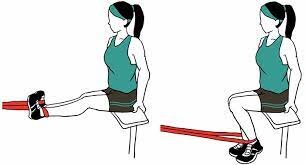
Side Walk with Band
- Begin in a comfortable standing stance.
- Apply a resistance band directly over your ankle or knee at this point.
- Next, lower yourself to a squat and step to one side.
- You can start on the right side and work your way to the left in little steps.
- After that, go back to your neutral posture.
- Then unwind.
- 5–10 times, repeat these.
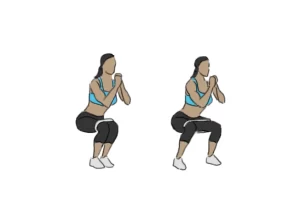
Clamshell
- Commence by resting comfortably on your side on the table.
- Clench your abdomen.
- Bend your knees now.
- Maintaining your feet together, raise your upper knee.
- Hold on for a brief while.
- Then drop your leg gradually.
- After that, go back to your neutral posture.
- Then unwind.
- Five to ten repetitions for each side.
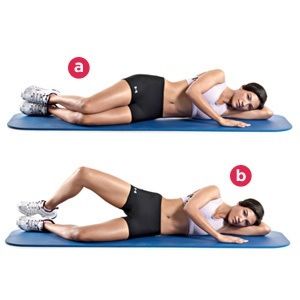
Stepping Up
- Commence by taking a comfortable standing position on the ground.
- Now set down a footstool with a single step on the ground.
- You can perform this exercise with your hands gripping a chair, counter, or wall for support.
- After maintaining a straight back, raise your afflicted leg.
- Next, place your remaining leg on the footstool.
- Hold on for a brief while.
- After that, go back to your neutral posture.
- Then unwind.
- Five to ten repetitions for each side.
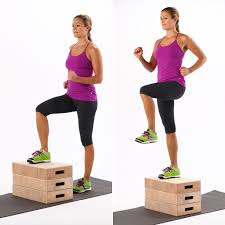
Clamshell Exercise With A Resistance Band
- Wrap the band slightly above the knees around each leg.
- Legs and hips stacked, knees at a 45-degree angle, lie on one side.
- To keep your core stable, tighten your abdominal muscles.
- Raise your upper knee as high as possible without shifting your hips or pelvis as long as your feet remain in touch with one another.
- At all times, maintain your lower leg on the ground
- Take a little break at the summit.
- After that, go back to your neutral posture.
- Then unwind.
- Five to ten repetitions for each side.
Hip Flexor Stretch
- Begin by bending both knees.
- Step forward with one foot now, and bend your knee to a 90-degree angle.
- You can lay your hands on your front knee for support if necessary.
- Maintaining an upright torso.
- Next, bend forward till a strain is felt.
- Keep your posture like this for a little while.
- Then take a gradual step back.
- After that, go back to your neutral posture.
- Then unwind.
- Five to ten times over.
- Repeat with your other leg.

Lying lateral leg Raises
- On the bed, begin in a comfortable side-lying posture.
- Keep both of your legs extended.
- Now, raise your leg straight up without causing your body to move as a whole.
- Hold on for a while.
- Then drop your leg gradually.
- After that, go back to your neutral posture.
- Then unwind.
- Five to ten times repeat in a day.
Hip Flexors At The Table’s Edge
- To begin, take a seat at a table or bed’s edge and hang both of your legs off the sofa or bed.
- Next, raise one leg towards your chest while simultaneously leaning back on the table.
- For 10–20 seconds, hold.
- Then drop your leg gradually.
- After that, gradually return to your neutral posture.
- Then unwind.
- Five to ten times again.
- Turn the other side over.
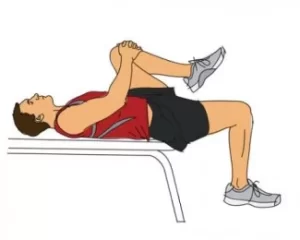
Hip abduction stretch
- With your feet, knees, and hips facing forward, take a straight stance.
- Raise and hold your left leg out to the side for a brief period of time.
- After that, gradually return to your neutral posture.
- Then unwind.
- Five to ten times over.
- Turn the other side over.
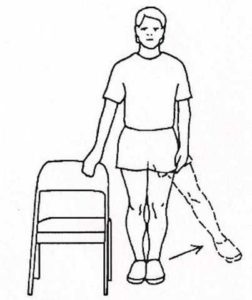
Hip extensions
- Grab onto anything at waist height, like a chair’s back.
- Stretch one leg out from behind you while maintaining a straight back and holding.
- After that, gradually return to your neutral posture.
- Then unwind.
- Five to ten times over.
- Turn the other side over.
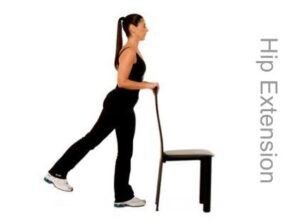
What Safety Precautions Are Required When Working Out?
- It is important to keep proper posture during exercise.
- Avoid doing intense workouts.
- Completely warm up before working out.
- If you get sudden pain when working out, stop.
- Strike the Right Balance
- Do not dehydrate.
When Do You Break And Stop Working Out?
- Excruciating muscle pain
- You spread easily.
- If numbness or pain are present.
- If the fever headache exercise aches, it should be halted.
Conclusions:
- Avulsion fractures of the anterior iliac spines are unusual acute injuries in athletic kids and young adults.
- They are caused by traumatic apophyseal avulsions, which primarily affect the anterior superior iliac spine.
- Apophyseal evaluation injuries are a specific pathology in athletes, children, and adolescents. It is essential to identify these injuries in order to prevent needless and expensive follow-up inquiries. The patient’s past heavily influences the diagnosis.
- In injuries occurring in the context of sports activities, without direct impact, and with a history of previous pain suggestive of apophysitis raise suspicion.
- Early and appreciative diagnosis and treatment of growth plate injuries are essential in preventing the occurrence of these types of fractures.
- The best course of action is still conservative therapy, which permits a return to sports without side effects.
SUMMARY:
- A traumatic avulsion of the anterior superior iliac spine (ASIS) that affects young athletes is caused by an abrupt and severe contraction of the sartorius and tensor fascia lata.
- The sartorius muscle and portion of the tensor fasciae lata originate in the anterior superior iliac spine, which arises from an anterior apophysis of the iliac crest. As a result, an anterior superior iliac spine avulsion fracture is most usually caused by a powerful contraction or sudden repetitive action of these muscles, such as when running or kicking a ball.
- When there are displaced injuries, the diagnosis is made radiographically; however, in the case of nondisplaced fractures, CT/MRI may be necessary.
- For fractures less than 3 cm in displacement, nonoperative treatment involves rest and safe weight bearing. Fractures that are more than 3 cm displaced should be treated surgically.
FAQs
The anterior inferior iliac spine: what is it?
The rectus femoris, one of the quadriceps muscles of the front of the thigh, attaches to a portion of the bone called the Anterior Inferior Iliac Spine (AIIS), which is located directly above the hip joint.
An AIIS avulsion fracture: what is it?
“Avulsed” translates to “pulled off.” The rectus femoris muscle contracts forcefully, separating the muscle’s bone origin through the unfused growth plate. This usually happens when kicking a football. Avulsion fractures with AIIS are comparatively uncommon injuries primarily affecting adolescent athletes. During adolescence, the bone is somewhat weak and the muscles are relatively strong. The development plate between the AIIS and the pelvic ilium bone is a weak area until the two bones fuse together at skeletal maturity in late adolescence. The AIIS arises from one of the minor growth centers that divide from the main pelvic bones.
How much time does recovery take following surgery for an avulsion fracture?
Four to six weeks following the fracture is when the majority of the healing occurs. Any more aches or discomforts are typical. When you attempt activities you haven’t done in a long, this frequently occurs. Additionally, it’s typical for the area to remain more sensitive for a few months following the injury.
Can someone who has an avulsion fracture exercise?
Early exercise and movement:
Comply with the following exercises without creating undue discomfort. By doing this, you can prevent your foot and ankle from getting overly rigid. The healing process will be aided by these activities. Early weight bearing, or placing weight through the wounded foot, aids in hastening the healing process
To what muscle does the anterior superior iliac spine belong?
The anterior superior iliac spine is the term used to describe the anterior extremity of the pelvic iliac crest. This is a palpably important surface landmark. The tensor fasciae lata muscle, the sartorius muscle, and the inguinal ligament can all attach to it.
Is physical therapy necessary following an avulsion fracture?
For early weight bearing and return to play after avulsion injuries, physical rehabilitation is crucial. After an avulsion fracture, reducing pain and swelling is the main objective. For the bone to heal, this calls for the use of cold, compression, and enough rest.
How can avulsion fractures be avoided?
Before engaging in any sport, warm up and stretch.
In any sport, avoid overexerting oneself.
Steer clear of abrupt movements (such as twisting or changing directions).
Engage in pelvic muscle strengthening and improvement activities.
After a fracture, is physiotherapy beneficial?
This is, in fact, among the best therapies for fractures. Physiotherapy reduces joint stiffness surrounding shattered limbs and permits the damaged limbs to be strengthened during the initial stages of healing. Later, using various modalities can also help reduce pain and swelling in places that are not impacted.
Is it possible to totally heal after an avulsion fracture?
For a few weeks, you might have to wear a cast or splint. It typically takes three to twelve weeks for a fracture to fully heal.
How are avulsions treated at home?
Clean your wound: Both before and after providing wound care, wash your hands with soap and water.
Elevate your wound by placing pillows under it to raise it above your heart level.
Cover your wound with bandages to prevent infection and to keep it dry and clean.
An avulsion fracture is treated with heat or ice.
Applying heat or ice to treat a fractured bone works similarly to applying either to treat shoulder discomfort. Ice is usually useful to reduce pain, swelling, and inflammation after a recent injury. Heat therapy may be beneficial later in the healing phase to improve range of motion and mobility.
What is a basic at-home exercise program for anterior superior iliac spine fractures?
Clamshell
Clamshell Exercise With A Resistance Band
Hip flexor stretch
Hip extensions
Hip abduction
What is the right time for someone with an anterior superior iliac spine fracture to exercise?
You can work out for at least thirty to forty minutes every day.
Stretching and exercising gradually will help you.
What does need one to do in the event of an injury?
Returning too soon runs the risk of aggravating the injury and causing lasting harm. It is imperative to rest and abstain from any activities that may have aggravated the problem.
How is the ASIS avulsion treated?
Internal fixation and open reduction are the usual surgical procedures for an ASIS avulsion fracture.
Why do ASIS fractures occur?
This injury commonly results from the sartorius muscle and tensor fasciae lata contracting suddenly, forcefully, or repeatedly. Football players, gymnasts, and sprint athletes are the ones most frequently impacted because of the variety of movements they do and the sudden direction changes they must make.
Can a fracture from an avulsion heal without surgery?
Avulsion fractures are usually treated with rest, ice, and carefully monitored exercise programs designed to build muscle strength, increase range of motion, and encourage bone mending. The majority of avulsion fractures heal quite effectively without the need for surgery.
What is the avulsion fracture’s immediate course of treatment?
Immobility with a splint or cast.
Medicines that reduce inflammation.
Restriction of activity.
Icing the area.
Physical therapy with exercises.
What is the age of an ASIS avulsion fracture?
anterior superior iliac spine apophyseal avulsion injury (ASIS). Between the ages of 13 and 15, the ASIS apophysis begins to ossify, and between the ages of 21 and 25, it unites with the ilium. The sartorius muscle and a few tensor fascia lata fibers link to the ASIS.
Which variables put one at risk for avulsion fractures?
Avulsion fractures are a common injury among athletes. Young athletes whose bones are still growing are more likely to experience them. When playing or practicing too hard, too frequently, or with incorrect techniques, children may be more susceptible to these fractures.
What is your typical gait following a fracture?
You will most likely require crutch or walker help in the early stages of the healing procedure. After an injury or surgery, the patient may be able to bear as much weight as possible on the leg in some situations; but, you might not be able to bear your entire body weight on the leg until the fracture has healed.
When you have an anterior superior iliac spinal fracture, what should you not do?
It is advised that you refrain from all high-impact activities, such as sports and exercise, to allow the bone time to heal. Additionally, you should refrain from bending, twisting, or lifting. This does not, however, imply that you should remain inactive until the fracture heals.
References:
- Exercise, Therapy Exercises for the Hip. n.d. Physiopedia. https://www.physio-pedia.com/Therapy_Exercises_for_the_Hip. “Hip-Rehabilitation Exercises,” n.d., is cited inside.
- Professional, C. C. M. n.d. Avulsion Fracture. Cleveland Clinic. https://my.clevelandclinic.org/health/diseases/21802-avulsion-fracture. In-Text Citation: (Professional, n.d.)
- Anterior Iliac Spine Avulsion – Children – Conditions – Paediatric – What We Treat – Physio.co.uk. n.d. . https://www.physio.co.uk/what-we-treat/paediatric/conditions/children/anterior-iliac-spine-avulsion.php. Inside-Text Citation: “Physio.co.uk – Anterior Iliac Spine Avulsion – Children – Conditions – Paediatric – What We Treat,” n.d.
- FAQs | Hip and Pelvis | Doctor Articles | Asia Medical Specialists. n.d. Anterior Inferior Iliac Spine Avulsion Fracture. Copyright (c) Firmstudio Limited, 2005-2016. Reserved rights apply. [https://asiamedicalspecialists.hk/en/health-info/52/FAQs/Avulsion-Fracture-of-the-Anterior Insuliac Spine]. |In-text Citation: (“FAQs | Hip and Pelvis | Doctor Articles | Asia Medical Specialists | Anterior Inferior Iliac Spine Avulsion Fracture,” n.d.)
- Souder, C. n.d. Anterior Superior Iliac Spine (ASIS) Avulsion – Knee & Sports – Orthobullets. https://www.orthobullets.com/sports/3091/anterior-superior-iliac-spine-asis-avulsion. In-Text Citation: (Souder, n.d.)

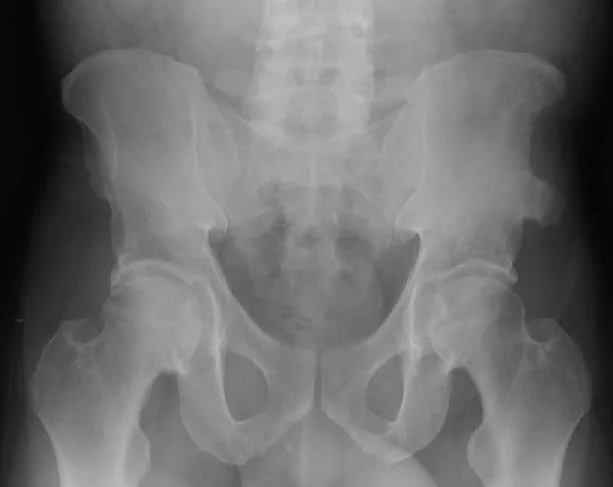
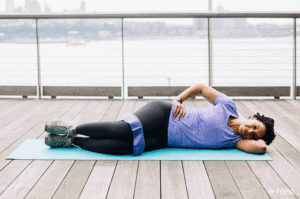
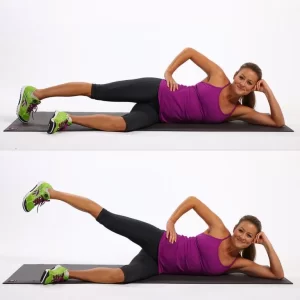
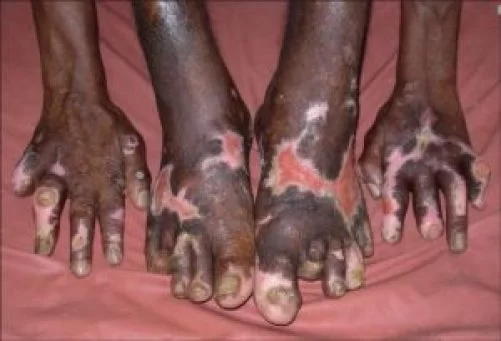

One Comment